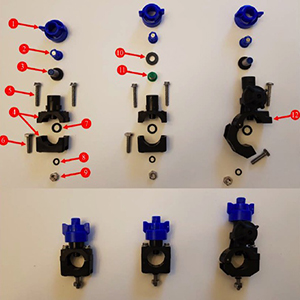Aeroponic systems design: considerations and challenges

Published: 15 September 2022
Abstract Views: 4794
PDF: 1537
Appendix: 125
HTML: 2740
Appendix: 125
HTML: 2740
Publisher's note
All claims expressed in this article are solely those of the authors and do not necessarily represent those of their affiliated organizations, or those of the publisher, the editors and the reviewers. Any product that may be evaluated in this article or claim that may be made by its manufacturer is not guaranteed or endorsed by the publisher.
All claims expressed in this article are solely those of the authors and do not necessarily represent those of their affiliated organizations, or those of the publisher, the editors and the reviewers. Any product that may be evaluated in this article or claim that may be made by its manufacturer is not guaranteed or endorsed by the publisher.
Similar Articles
- Seth Laurenson, Laura Villamizar, Remy Lasseur, Rhys Fitzgerald, Shengjing Shi, 3D-printed biological habitats for the protection and persistence of Rhizobia species in compacted soils , Journal of Agricultural Engineering: Vol. 53 No. 4 (2022)
- Xin Du, Cailing Liu, Changqing Liu, Qixin Sun, Shufa Chen, A novel method for measurement of the angle of repose of granular seeds in discrete element methods , Journal of Agricultural Engineering: Vol. 54 No. 2 (2023)
- Annamaria Costa, Marcella Guarino, PARTICULATE MATTER CONCENTRATION AND EMISSION FACTOR IN THREE DIFFERENT LAYING HEN HOUSING SYSTEMS , Journal of Agricultural Engineering: Vol. 40 No. 3 (2009)
- Alessandro Biglia, Francesco Gresta, Davide Lucien Patono, Lorenzo Comba, Claudio Lovisolo, Paolo Gay, Andrea Schubert, Identification of drought-salinity combined stress in tomato plants by vegetation indices , Journal of Agricultural Engineering: Early Access
- Salvatore Margiotta, TECHNICAL CHARACTERIZATION OF ECO-COMPATIBLE PLASTIC FILMS FOR SOIL SOLARIZATION: FOUR YEARS OF EXPERIMENTS , Journal of Agricultural Engineering: Vol. 38 No. 4 (2007)
- Xiaoqiang Du, Tengfei Shen, Kaizhan Chen, Guofeng Zhang, Xiaohua Yao, Juanjuan Chen, Yongqing Cao, Simulation study and field experiments on the optimal canopy shaking action for harvesting Camellia oleifera fruits , Journal of Agricultural Engineering: Vol. 53 No. 3 (2022)
- Stanimir Stoilov, Salvatore F. Papandrea, Georgi Angelov, Delyan Oslekov, Giuseppe Zimbalatti, Andrea R. Proto, Productivity analysis and costs of wheel cable skidder during salvage logging in European beech stand , Journal of Agricultural Engineering: Vol. 54 No. 2 (2023)
- M. Hellstedt, K.O. Kaustell, T. Kivinen, The occupational safety on the construction sites of the farm production buildings in Finland , Journal of Agricultural Engineering: Vol. 44 No. s2 (2013): Proceedings of the 10th Conference of the Italian Society of Agricultural Engineering
- Lucia Recchia, Paolo Boncinelli, Enrico Cini, Alternative method for vegetables cultivation in Benin , Journal of Agricultural Engineering: Vol. 44 No. s2 (2013): Proceedings of the 10th Conference of the Italian Society of Agricultural Engineering
- Kishor P. Kolhe, Demelash G. Lemi, Siraj K. Busse, Studies of tractor maintenance and replacement strategies of Wonji Shoa Factory, Ethiopia , Journal of Agricultural Engineering: Vol. 55 No. 1 (2024)
<< < 31 32 33 34 35 36 37 38 39 40 > >>
You may also start an advanced similarity search for this article.

 https://doi.org/10.4081/jae.2022.1387
https://doi.org/10.4081/jae.2022.1387







